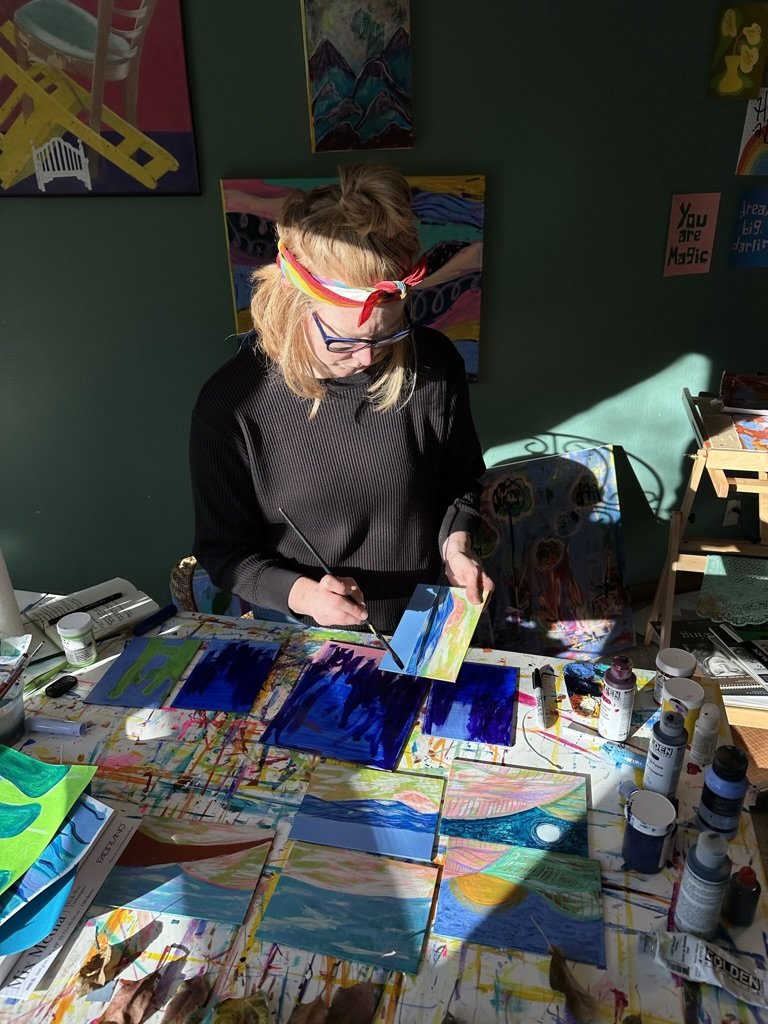Redefining Wellness: A Guide to Living Well with Chronic Health Issues
I believe wellness is available to everyone. But the wellness I’m talking about is very different from what you might first think of…
Fun free association game!
What comes to mind when you hear “wellness”? Take note of the first 4-5 words, phrases, or images that arise. (Maybe even jot them down to revisit later.)
Many of our beliefs and our behaviors related to wellness are shaped, whether we know it or not, by two complex systems: the wellness industry and the healthcare industry.
As a hospital-trained occupational therapist and yoga teacher, I myself straddle these worlds. I know excellent practitioners who work in one or both systems with care and integrity. There is good to be found in both.
However, the health and wellness industries are profoundly failing us.
The wellness industry has exploded in the past few decades, leaving in its wake a never-ending list of things we should be doing to “be well.”
It has engendered a toxic culture rooted in consumerism that promotes fads and quick-fixes over sustainable, human-centered support.
A proliferation of specific dietary protocols, each with their own bold claims (and accompanying product lines).
Extravagant spa days, body wraps, anti-aging products.
Adaptogenic teas, the latest “super-food” (maybe or maybe not ethically sourced).
The newest intensive movement program that happens to require expensive equipment and umpteen hours of your time…
The list goes on and on.
I’m not saying that all these things are inherently harmful.
Some are. Some are marketed in deeply problematic and misleading ways that manipulate people who are already vulnerable and desperate.
However, as I see it, the biggest problem is that wellness culture keeps us focused on the trappings, not the heart of true wellness.
As we strive to become our “best selves” (whatever that means) by following external voices, programs, and protocols, we suffer disconnection from our own inner wisdom and from real community.
“Wellness culture keeps us focused on the trappings, not the heart of true wellness.”
We become more and more entangled in comparison traps and the exhausting pursuit of perfection. There’s always something else to try (and to buy), so it’s never enough. And it becomes easy to believe you are never enough.
And what if you live with chronic health issues and have limited energy resources?
Maybe you’re barely managing basic self-care some days. How in the world are you supposed to do all this too? The cost of following the next big wellness trend can be especially high for people navigating life with chronic and complex health conditions.
And when we step back to appreciate the truly endless (and endlessly changing) list of “shoulds,” it begs the question: Who can actually be well?
This culture makes wellness unattainable for everyone except the most well-resourced and (at least temporarily) able-bodied.
And it has to.
Because, here’s the thing: this system collapses if you actually achieve wellness.
Furthermore, with its hyper-focus on individual action, toxic wellness culture also largely ignores the health of communities and neglects the ongoing impact of oppression and systemic inequity in forms such as racism, homophobia, sexism, and ableism.
Healthcare has its own problematic stories and assumptions about wellness.
The first is that wellness is simply the opposite of illness.
In this oversimplified binary of "well versus ill," the healthcare system erroneously conflates a lack of medical diagnoses with true wellness.
Are all people without preexisting conditions experiencing holistic wellness in their lives? No, certainly not.
Defining wellness as merely the absence of diagnoses or active disease is the narrowest and least meaningful definition of wellness. And it robs us all of the opportunity to consider what flourishing actually looks like.
“In some ways, healthcare seems wholly uninterested with wellness, opting to lie in wait until a problem emerges or gets a lot worse.”
By extension, the second assumption is that if you are living with chronic, flaring, and/or complicated health issues, you cannot experience wellness.
Not only is this deeply ableist, but it also can negatively impact care provision.
Symptoms may be glossed over or downplayed as “typical” for XYZ condition without comprehensive assessment.
Providers may not initiate conversations about resources and support that could dramatically improve quality of life and reduce the impact of symptoms on day-to-day functioning.
In some ways, healthcare seems wholly uninterested with wellness, opting to lie in wait until a problem emerges or gets a lot worse.
Ultimately, the stories of toxic wellness culture and medicalized healthcare both miss the mark with their interpretations of what wellness does or should look like, particularly for those living with chronic health issues and/or disability.
We need a wider, more expansive understanding of wellness, one that allows for and even embraces our messy, beautiful humanity.
We need a vision of wellness that centers our capacity for creative adaptation and compassionate response to the inevitable waves of life.
Can you imagine this different way with me?
What if wellness looks like:
feeling aligned with your values,
being present in your relationships, and
thriving in the life you have?
Not an exhaustive to-do list, not a badge to be earned.
I believe living well and living with a health condition aren’t mutually exclusive.
I believe wellness is something we continually tend, like dedicated gardeners with beloved plants. The fruits of this tending look unique for each person and change throughout the seasons of life.
In every season, we are invited in different ways to nourish wellness by:
1. Nurturing self-compassion
Sometimes we get stuck in cycles of self-criticism, rumination, and feeling like we are alone in our experiences. Self-compassion nudges us to care for ourselves as we would a dear friend, especially in times of challenge, stress, and overwhelm.
This can look like:
Honoring the struggles & the joys
Befriending our bodies
Holding ourselves tenderly through the hard stuff
Discovering the inner advocate
2. Cultivating authentic connection
We thrive when we connect in meaningful ways to ourselves, to others, and to all those things that matter to us. This can be challenging in a culture that glorifies productivity, celebrates impersonal popularity, and generally keeps us hustling.
Instead we can commit to:
Discovering & deepening inner resources
Welcoming a mindful pace
Finding companions for the journey
Rooting into purpose & values
3. Supporting gentle change
We all have growing edges and areas in our lives where we’d like to see shifts. Bringing our kind attention to these and taking action is also part of the wellness journey.
We support gentle change by:
Centering the simple & sustainable
Setting generous intentions
Meeting challenge with creativity
Embracing the seasonality of life
For all the visual learners, here’s how I imagine this model of (Re)Defining Wellness:
Finding a new path to wellness in the midst of chronic health issues…
Remember those first few words that came to mind when you thought of wellness? Look back at (or think back to) the list you made.
Is there anything you want to leave behind?
How has your journey been impacted by toxic wellness culture or the medicalized healthcare system?
What does wellness mean to you?
I believe that wellness is incredibly personal and encompasses the physical, mental, emotional, social, and spiritual. It is about so much more than just managing symptoms and you get to define what it looks like.













